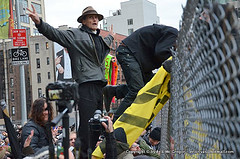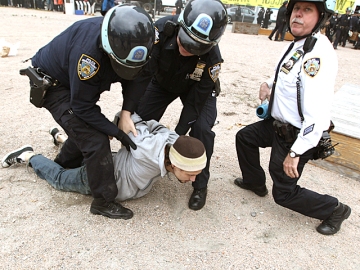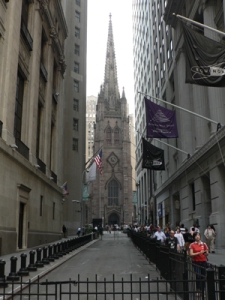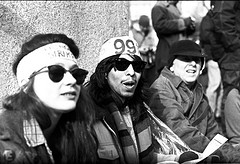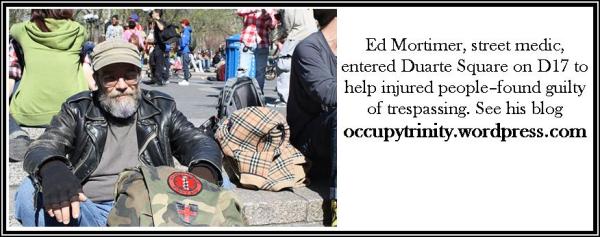
The first snow of 2009 in the northeast hit Saturday night and it was memorable. It brought to the present bits of my personal history with snow. An early memory was the time I tied with twine my grandfather’s ancient cross country skis brought from Sweden. Alone, I went out into the woods to explore. There, a storybook red fox crossed my path. We looked at each other for a while in silence. When the fox had had enough, he went on. I remained still, imprinting this on all my senses.
The nucleus of our spiritual journey is to find such moments – now. Jesus says “the Kingdom of God is coming, the Kingdom of God is here.” Faith tells me to walk with the belief that bidden or not, God is present.
The now of today incorporates snow cleansing the landscape, priming me for silence, awe, and the expectation that there are encounters yet to be. Today also asks me to be support for a local church’s Christmas pageant. I dig out the car, keeping in mind a promise I have made – particularly to 12-year-old Ryan.

Unloading a large bag of props for the pageant, I skate-slide my way across the parish parking lot’s tamped-down snow, walking in with focus. Passing the middle-aged female priest with cropped grey hair, she head pans a cheery “Good morning!” in my direction then goes right back to her conversation with another staff member. She’s ticked off the “welcome everyone” box on her to-do list. How would my experience have changed if she had walked with me? Or her experience had she had displayed some curiosity about the unfamiliar person who walks in such confident, familiar way through the halls?
I am spotting some of the props in the narthex when a couple in their late-forties arrives with the stomping of boots and other physical cues that the weather outside is frightful. Beautifully frightful. The husband wears a navy cashmere coat, a wool-silk reversible scarf nattily draped by the collar. His wife wears a full-length fur. Maybe sable.
“Ah Margaret! Don’t forget it’s our turn to bring up the elements!”
Yes, arrive wearing the cash equivalent of what could sustain a village in Micronesia for several years so you can tick off your Church duty as the one to bring up the symbols of Christ’s sacrifice and communion with the family of all humankind.

Halfway down the aisle in the nave I pause to light two candles. There are some things heavy on my heart. When I stand after my prayers, a different woman in a full-length fur, an expensive camera with a 5-inch telephoto lens around her neck, walks purposefully down the aisle. I am in transition, my eyes teary. She looks me full in the face, smiles brightly while saying “Good morning! Welcome!”
In this house of prayer and worship, everyone lives in the Land of the Oblivious. Well, nearly everyone. I encounter next the associate priest who smiles with his eyes rather than his teeth, asking me if there is anything he can do to help.
“No, thank you. And how is your stamina during this season?” I ask. “Enough time for your family?”
“Oh, you know how that is, but we’ll have time together over the break.”
This is a wealthy parish, founded by robber barons and early 20th century tycoons. These are the people who hated FDR for betraying his own class and there is a charism of that ethos. The parish is sustained by those who employ economic practices that continue to crush the poor and obliterate the middle class. The pulpit was silent when it came to the illegal invasion of Iraq, the torture of prisoners at Abu Ghraib. The relatives of those responsible for those policies might be offended.
The children on parade today may be the descendants of those robber barons – certainly many are the offspring of parents who enjoy the fruits plucked from the Wall Street system. At the moment, they are innocent, but the parish colludes with the culture in broadcasting messages about their “specialness”. There are the mission trips which pad college application c.v.s; the well-funded traditional chorister program which separates the sheep who bleat on pitch from the goats who are cast aside; rewards in the form of high-profile moments of recognition for the confirmation class attendees who obediently jump through hoops. When the children of this parish graduate from high school, the parish newsletter will print which public – or in most cases prep – school each one attended next to the name of the college the student will be attending.
All that’s missing is the glass case with engraved trophies.

But for me, I have a relationship with Ryan. Here is the Spirit. Here is where I need to read Ryan’s eyes and body language, allowing myself to be changed by being in the moment with this child. He can’t sing on pitch, he’s not aggressive. His readiness point is that he knows how to listen and watch interactively. There is trust in his eyes that makes my heart ootch. I want to be worthy of that trust.
The bulletin for the pageant takes up 8 folded legal-sized sheets of glossy paper, including a color cover with a child’s drawing of the manger. Sixteen pages for a very simple, apocryphal story or non-recycled paper. The pageant passes with moments of adorableness, enough mistakes to prevent any sense of it being canned. There is one African-American shepherd, a Latino Joseph, and an Asian angel. A display of diversity so that the parish can feel it’s not entirely insular. Everyone who owns a fur – and that is a large percentage of the female population – has worn it to church. Enough to costume a pageant sequel with northern fur-bearing critters around the manger instead of cows and sheep. The woman with the camera is taking snapshots.
But Ryan and I are collaborating off to the side making sound effects. Coconut shells for donkey hooves, a different bell sound for each angel, a wood block for knocking on innkeepers’ doors. Ryan is alive – watching, listening, completely off script. Both of us are practicing the productivity of playfulness. Kids are some of the most professional people you’ll ever work with. Ryan takes seriously that he is there to support the story of the nativity. Our relationship allows me to tolerate this community and I am grateful for Ryan for that gift.
I lose all the warm fuzzy feelings generated by the pageant when the priest steps out and tells us what it’s supposed to mean. Another “don’t bother” message from the clergy. Don’t ponder, don’t rest in the mystery of the incarnation. Here’s what he said it’s all about: We are all children of God.
We have announcements, and I am struck by how program-heavy this parish is. There are upcoming speakers, concerts, choir tours, book clubs, breakfasts, and classes.
The Eucharist begins, Margaret and her husband present the elements. Everything devolves into words on paper, laundry lists for me. I pray earnestly for God to help me find some meaning in all this. The prayer is repeated like a mantra and immediately before I am about to receive my prayer is answered. I see an image of the Bodhi tree, intercessions on paper fluttering in the wind, coupled with the sound of the words of one of the Eucharistic prayers where we ask that we do not come to the table with our own sense of righteousness. I receive communion in honor of someone else.

Back in the pew, I have a vision. At least I think I have a vision. What comes to me is this:
The last churches standing will be those that embody “church as club”. They will be a bit like conservatories – conserving tradition drawn from a small region in Northern Europe that coincides with the height of the British Empire. Sixty years of tradition extracted from 2,000. The rector will be selected for his or her capacity to keep pledges up, so that the right club atmosphere in terms of program is maintained. Just enough “learning” and mission to give a sense of corporate self-improvement. To paraphrase someone much wiser than myself: the church needs charity to deflect its energy from justice.
The poor churches will not fade. They will be absorbed into community like salt in the ocean. People will once again “be church” to each other. They will worship in Spirit and Truth. And this is where the world will turn. This is where the fire of hope burns just as it did in a cave a few thousand years ago.
Justice will rise, as it has for generations, from those who seek it the most. The de-churched, divorced from the agenda-driven church, will birth the Kingdom of God. We will acknowledge that we are on a spiritual journey. We will listen to each other and keep our lamps trimmed.
The worship over, I pack up my bags. Ryan runs up to say “Thanks, that was fun.” The associate priest thanks me too with a full sense of sincerity. It is only a moment, but we listen to each other’s holiday plans, wishing each other blessings and restorative time. This is enough.
The day remains cold so that the snow keeps its powdery silence. At home, I have my own agenda to tend to – clean up, prepare for the work week, cook enough meals for the family. But every time I look out the window, I expect to see a storybook red fox.
My soul doth magnify the Lord. My spirit rejoices in God my Savior. Help me to be in the moment, to live with compassion, to be flexible, to stop all agendas so that I may find your Spirit and your will.




